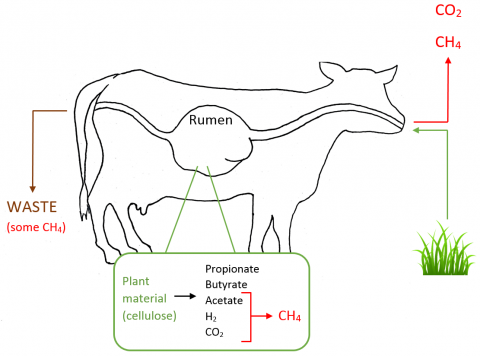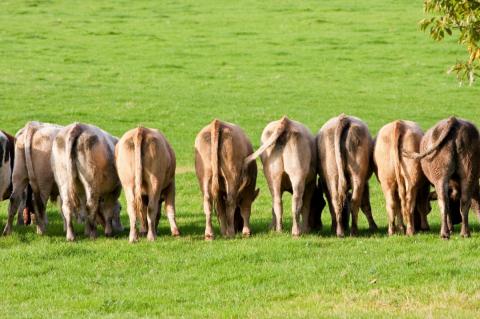27 February 2019
Cate Williams: IBERS, Aberystwyth University.
Methane (CH4) is a well-known greenhouse gas (GHG) with a global warming potential 28 times that of carbon dioxide (CO2). The agricultural sector contributes significantly to anthropogenic (human-caused) CH4 production, although estimates vary depending on calculation method. The consensus states that the agricultural industry contributes somewhere between 7 and 18% of total anthropogenic GHGs and around 6% of total CH4 emissions. The breakdown of plant material in the rumen (enteric fermentation) constitutes approximately 87% of total agriculturally produced CH4. This CH4 production from enteric fermentation also represents a loss of energy for the animal (up to 12%) which could otherwise be used for growth or milk production. It is therefore not only crucial for the benefit of the environment and in climate change mitigation to reduce CH4 emissions, but also to increase the production efficiency of ruminant livestock. Ruminants themselves are not the only producer of CH4 on the farm, with manure/waste, farm vehicles and machinery and animal feed production also making a contribution (Figure 1).
- Climate change remains a critical worldwide problem and it is well known that humanity’s prolific production of GHGs is a contributing factor. Methane is a GHG with 28-fold the global warming potential of CO2.
- The agricultural sector is a significant contributor of CH4, in particular from fermentation carried out by ruminants (cows, sheep, goats etc.).
- Mitigation strategies targeting the rumen are a source of dynamic and novel scientific research, although few current strategies are consistently effective or suitable for commercial application.
How and why is methane produced?
Ruminants are aptly named after their unique digestive system, which is comprised of four chambers: the reticulum, rumen, omasum and abomasum. Of interest here, is the rumen, which contains a diverse and dynamic population of microorganisms that enable the animal to break down tough plant material and convert it into high-quality nutrients. The rumen microbial population consists of bacteria, fungi, protozoa, viruses and archaea, which work symbiotically to provide nutrients for themselves and for the animal. The rumen has been a significant focus of scientific research over the years, offering alternative antibiotic compounds and enzymes that have increased the efficiency of various industrial processes. Research has been conducted to investigate the effects of manipulation of the microbial population on production, feed efficiency, meat and milk quality and of course CH4 emissions. Various digestive processes in the rumen generate CH4 amongst other gases, which are released through eructation (belching) and flatulence (Figure 2). Methane is a by-product of essential processes that deliver protein and energy-yielding nutrients for the animal (e.g. short chain fatty acids) (Figure 2). The processes generating CH4 in the rumen are highly complex and rely on microbes known as archaea convert CO2 and Hydrogen (H2) into CH4. Archaea are ancient, single-celled microorganisms that are distinctly different to other microbes like bacteria and fungi. A sub-group of archaea named methanogens are responsible for the vast majority of CH4 production in the rumen, constituting on average 78% of the entire rumen archaeal population. When analysing the abundance and community structure of methanogens in the rumen, research has found that it is not the overall number of methanogens that dictates how much CH4 is produced. Instead, the structure of the microbial community and the presence or absence of different species have a much more significant effect. On this basis, three distinct types (‘ruminotypes’) have been identified, which dictate how much CH4 the animal produces: Types Q and S produce less CH4 than type H. Further studies by Difford et al. (2018) also suggests a strong correlation between animal genetics and CH4 emissions, which makes genetic selection a promising strategy for breeding a new population of low-methane emitting cows.
Figure 2: Diagrammatic representation of sources of methane from ruminants.
Mitigating methane emissions from ruminants
A wide range of experimental strategies for CH4 mitigation have been proposed including selective breeding for low-methane producing animals, vaccines, changes in management practices, feed additives and other techniques that directly manipulate the rumen microbiome. The vast majority of interventions remain experimental, with most methods not having reached the stage of animal trials. Nevertheless, such strategies provide important and novel concepts that will undoubtedly be applied in the future and will be covered in a subsequent article.
Changes in concentrates & forage
The proportion of concentrate in the ruminant diet has been found to have a direct effect on CH4 emissions. The lower the ratio of concentrates: forage that a ruminant consumes the more CH4 is produced. Starch-based concentrates in particular decrease CH4 production as less acetate and more propionate is formed thus limiting the supply of hydrogen available for conversion to CH4 (Figure 2). These feeds also cause the rumen pH to decrease to slightly acidic levels (due to increased levels of propionate which is acidic in nature) which in turn reduces the activity of CH4 producing microbes. Fibre-based concentrates have also been demonstrated to reduce CH4 output when fed at pasture; one study reported 16 - 19 g less CH4 was produced per kilogram of milk. However, feeding increased levels of concentrate is not an economically viable option for many farmers and can lead to health problems such as acidosis. Fibre is a vital constituent of the ruminant diet and should constitute 20-30% of total intake, so care should be taken when adjusting concentrate: forage ratios.
Forage types and quality have also been investigated for their effects on CH4 emissions. Feeding forage that is less mature or more processed (rendering it more digestible) resulted in a reduction of 15 to 20% in modelled scenarios. Legume-based forage is known to reduce CH4 emissions due to the presence of naturally occurring tannins. Tannins are toxic to some microorganisms in the rumen, particularly methanogens, reducing the CH4 producing capacity of the rumen microbial population. Leguminous forage has a faster rate of passage from the rumen, this is due to the less fibrous plant structure making it easier to digest whilst limiting the period in which methanogens can attach and digest, creating CH4. Leguminous forage has also been shown to increase milk production, provide an excellent source of protein with some types of forage, such as Sainfoin and Bird’s-Foot Trefoil, helping to prevent bloat. That said any method that manipulates the rumen microbiome should be approached with caution, as studies have reported decreased overall digestibility due to the reduction in microbes that are involved in both CH4 production and plant degradation. Additionally, many species of legumes are known to cause bloat (Alfalfa and a wide variety of clovers) when fed in high proportions.
Lipid supplementation
Good evidence exists to support a reduction in CH4 emissions when feeding additional oil or lipids, with up to 25% less enteric CH4 produced. Dietary lipid supplementation works by decreasing fermentation of organic matter and through toxicity to rumen methanogens. Unsaturated fatty acids, in particular (i.e. those not saturated with hydrogen) can also act as a hydrogen sink, as the fatty acids are preferentially hydrogenated leaving little hydrogen left for conversion into CH4 (Figure 2). However, it is recommended that fat does not exceed 7% of the ruminant diet otherwise dry matter intake (DMI) may become depressed leading to reduced fibre intake and poor digestibility. The effectiveness of lipid supplementation depends on many factors: the level of supplementation, fat source, fat profile and overall diet. Some of the most promising results have stemmed from coconut oil (63% reduction in CH4 when 7% oil was added) and palm oil (58% reduction in CH4 when 5% was added).
The feeding of refined oils as a methane mitigation strategy is unlikely to be commercially viable simply due to the high cost of supplementation. As such, oilseeds and animal fats have also been investigated; whilst these fats do not produce results of the same magnitude, they also do not depress DMI and digestibility to such a degree. In dairy cows, high levels of supplementary fat can reduce milk fat percentage and change the fatty acid profile. This outcome may, or may not be desirable; therefore, care should be taken in choosing the appropriate fat source and level of supplementation.
Feeding Probiotics
Microbial feed additives have been developed to directly influence the rumen microbial population and improve fermentation. The most widely used pro-biotics are yeast and Aspergillus oryzae although their exact mechanism of action is not clear. These additives are hypothesised to work in one or more of the following ways:
- Increasing butyrate and propionate levels and reducing the proportion of acetate thus limiting the precursors necessary for CH4 production (Figure 2).
- By reducing the number of methanogens and associated microbes.
- By increasing the breakdown of acetate so that less is available for the subsequent production of CH4 (Figure 2).
- Improving animal productivity.
However, inconsistent results have been observed, with some studies reporting no significant differences in CH4 production and others observing reductions of up to 8%. Additionally, probiotics must be fed daily and therefore do not suit all farming systems, in this instance application may be most appropriate in dairy and intensive beef production systems.
Summary
Combatting climate change continues to feature at the top of the agenda for the United Nations council and the need to reduce anthropogenic GHG emissions is unequivocal. Methane represents an extremely potent GHG, with 28-fold the global warming potential than CO2, trumped only by the less abundant NO2. Should we wish to soften the blow of this long-term disaster, global society must collaborate to minimise GHG emissions. The agricultural sector is no exception, contributing around 6% of total anthropogenic CH4 emissions there is certainly room for improvement. Various mitigation methods exist and the quest to develop new and robust strategies has been a driving force for scientific research. Covered in this article, are some of the better known and better-established mitigation methods, however, these techniques still leave a great deal to be desired. Inconsistent results, adverse effects on the animal and unsuitability to certain farming systems are the primary concerns. Therefore, it is now time to accelerate research into novel mitigation strategies using the new, innovative biological technologies that sit at our fingertips.



